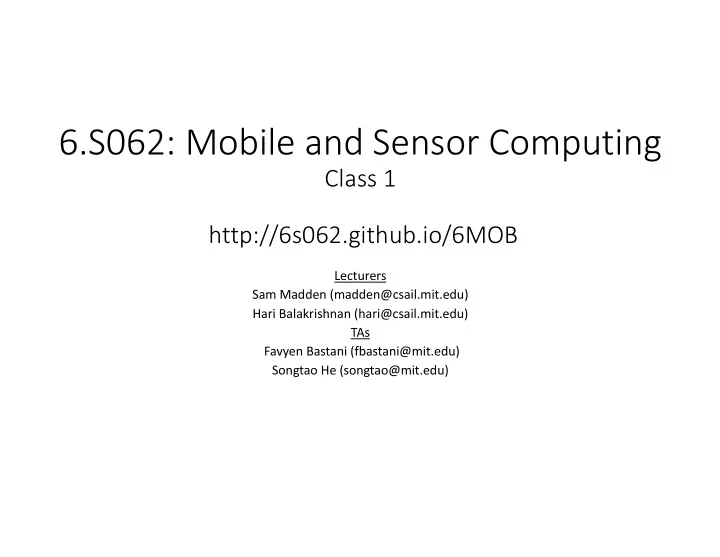

6.S062: Mobile and Sensor Computing Class 1 http://6s062.github.io/6MOB Lecturers Sam Madden (madden@csail.mit.edu) Hari Balakrishnan (hari@csail.mit.edu) TAs Favyen Bastani (fbastani@mit.edu) Songtao He (songtao@mit.edu)
PROTOTYPICAL SENSOR SYSTEM ARCHITECTURE Data path: sensors è “the cloud” phones/basestations è cloud Cleaned Sensors use low-power (BTLE, data; Zigbee) wireless gateways analysis & insights; Phones and gatewaysuse WiFi, control cellular, or wired Internet links phones signals Processing happens on sensors, data basestations, phones, and cloud sensors
OUR IOT EXPERIENCE Cricket Indoor Location System Pothole Patrol DriveWell safe driving Lutron Light Control app and BTLE app for controlling accident- lutron lighting detection systems from iPhone device iCarTel crowdsourced Pipenet traffic aware routing app
CASE STUDY: DRIVEWELL + TAG Key capabilities: “safety score”, end-to-end collision alerting facility Requirement 5: Requirement 2: Accurately measure < 5% battery drain / mileage and detect hour when driving Requirement 1: various harsh events 3+ years battery life Amazon AWS Cloud Requirement 3:10 Requirement 4: Acceleration Data second end-to-end Real time trip Impacts notification of feedback in a few Trip starts (triggered) accidents minutes (Over BLE) Trip data: Acceleration Gyroscope Position
DRIVEWELL DATA CHALLENGES Users move phone while driving GPS doesn’t follow roads Certain classes of devices experience failures
AN ANTERNET OF THINGS
VTRACK/CTRACK Tradeoff between accuracy and cost
VTRACK/CTRACK Tradeoff between accuracy and cost To this… From this…
EXAMPLE: ZEBRANET
My PhD – Sensor Networks & TinyDB Habitat Monitoring: Storm petrels on Great Duck Island, microclimates on James Reserve. Earthquake monitoring in shake- test sites. 30m: 109,108,107 20m: 106,105,104 10m: 103, 102, 101 Traditional monitoring Redwood Forest Monitoring apparatus. 14
TinyDB: The Network is the Database • Users specify the data they want – Simple, SQL-like queries – Using predicates, not specific addresses The Power of • Challenge is to provide: Declarative – Expressive & easy-to-use interface Thinking! – Power efficient execution framework » Efficiently fetches data from network » While capturing as much data as possible Many research groups became excited about related set of ideas in early 2000’s 15
Aggregation Queries “ Count the number occupied SELECT AVG(sound) 2 nests in each loud region of FROM sensors EPOCH DURATION 10s the island. ” Epoch region CNT(…) AVG(…) 3 SELECT region, 0 North 3 360 CNT(occupied) 0 South 3 520 AVG(sound) FROM sensors 1 North 3 370 GROUP BY region 1 South 3 520 HAVING AVG(sound) > 200 EPOCH DURATION 10s Regions w/ AVG(sound) > 200 16
ILLUSTRATION: IN-NETWORK DATA PROCESSING IN TINYDB Multihop data collection Time SELECT COUNT(*) FROM –Divide sample period into short time Interval 4 sensors intervals –Assign each node to an interval 1 according to its depth in the tree Sample Period 2 3 Key idea: combine data as it is transmitted in the network 4 5
ILLUSTRATION: IN-NETWORK DATA PROCESSING SELECT COUNT(*) FROM Interval 3 sensors Sensor # 1 1 2 3 4 5 2 4 1 3 3 2 2 Interval # 2 4 1 4 5 18
ILLUSTRATION: IN-NETWORK DATA PROCESSING SELECT COUNT(*) FROM Interval 2 sensors Sensor # 1 1 3 1 2 3 4 5 2 4 1 3 3 2 Interval # 2 1 3 4 1 4 5 19
ILLUSTRATION: IN-NETWORK DATA PROCESSING SELECT COUNT(*) FROM 5 Interval 1 sensors Sensor # 1 1 2 3 4 5 2 4 1 3 3 2 Interval # 2 1 3 4 1 5 4 5 20
ILLUSTRATION: IN-NETWORK DATA PROCESSING SELECT COUNT(*) FROM Interval 4 sensors Sensor # 1 1 2 3 4 5 2 4 1 3 3 2 Interval # 2 1 3 4 1 5 1 4 1 5 21
ILLUSTRATION: IN-NETWORK DATA PROCESSING Nodes can sleep most of the time Each node transmits only one COUNT SELECT COUNT(*) FROM Interval 4 sensors Sensor # 1 1 2 3 4 5 2 4 zzz zzz zzz 1 3 3 zzz zzz 2 zzz Interval # 2 1 3 zzz zzz 4 1 5 zzz zzz zzz zzz 1 4 zzz zzz zzz 1 5 22
POTHOLE PATROL
CLASSIFICATION-BASED APPROACH Classifier differentiates between several types of anomalies Window data, compute features per window Variety of features: Range of X,Y ,Z accel Energy in certain frequency bands Car speed …
POWER USED BY SOME COMMON COMPONENTS Component Approximate Power Consumption LTE Radio (transmit @ 1 Mb/s) 1700 mW 3G Radio (transmit @ 1 Mb/s) 1700 mW WiFi (transmit @ 1Mb / s) 400 mW Collecting the data is ARM+RAM uProc (100% cpu) 2000 mW cheap; displays & ARM+RAM uProc (idle) 70 mW radios & processing Smartphone Screen (full brightness) 850 mW are expensive GPS (once lock is acquired) 100-150 mW Accelerometer (@10 Hz) 75 uW Image sensor (@1080p/30Hz) 270 mW (Sony IMX206CQC)
CASE STUDY: DRIVEWELL + TAG Key capabilities: “safety score”, end-to-end collision alerting facility Requirement 5: Requirement 2: Accurately measure < 5% battery drain / mileage and detect hour when driving Requirement 1: various harsh events 3+ years battery life Amazon AWS Cloud Requirement 3:10 Requirement 4: Acceleration Data second end-to-end Real time trip Impacts notification of feedback in a few Trip starts (triggered) accidents minutes (Over BLE) Trip data: Acceleration Gyroscope Position
TOPICS • Positioning technologies, including GPS, WiFi and cellular localization • Wireless networking, including BLE, WiFi, Zigbee, as well as multi-hop and store-and- forward ("muling") • Resource constraints, including power, bandwidth, and storage • Inertial sensing, including accelerometers, gyroscopes, IMUs, dead-reckoning • Other types of sensors, e.g., microphones and cameras • Application studies • Embedded hardware and software architecture • Embedded system security • iOS APIs for accessing various sensing and wireless networking technologies
Recommend
More recommend